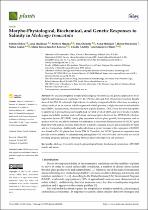| dc.description.abstract | We used an integrated morpho-physiological, biochemical, and genetic approach to investigate the salt responses of four lines (TN1.11, TN6.18, JA17, and A10) of Medicago truncatula. Results
showed that TN1.11 exhibited a high tolerance to salinity, compared with the other lines, recording a
salinity induced an increase in soluble sugars and soluble proteins, a slight decrease in malondialdehyde (MDA) accumulation, and less reduction in plant biomass. TN6.18 was the most susceptible
to salinity as it showed less plant weight, had elevated levels of MDA, and lower levels of soluble
sugars and soluble proteins under salt stress. As transcription factors of the APETALA2/ethylene
responsive factor (AP2/ERF) family play important roles in plant growth, development, and responses to biotic and abiotic stresses, we performed a functional characterization of MtERF1 gene.
Real-time PCR analysis revealed that MtERF1 is mainly expressed in roots and is inducible by NaCl
and low temperature. | en_US |

